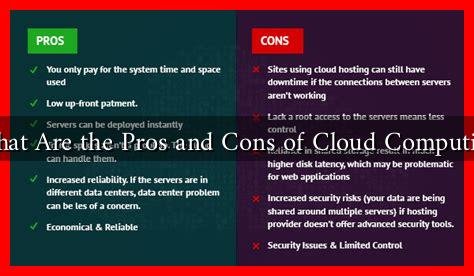-
Table of Contents
What Are the Pros and Cons of Cloud Computing?
Cloud computing has revolutionized the way businesses and individuals store, manage, and process data. By leveraging the internet to access computing resources, organizations can scale their operations, reduce costs, and enhance collaboration. However, like any technology, cloud computing comes with its own set of advantages and disadvantages. This article explores the pros and cons of cloud computing, providing valuable insights for businesses considering this technology.
The Advantages of Cloud Computing
Cloud computing offers numerous benefits that can significantly enhance operational efficiency and flexibility. Here are some of the key advantages:
- Cost Efficiency: One of the most compelling reasons to adopt cloud computing is its cost-effectiveness.
. Businesses can reduce capital expenditures by eliminating the need for physical hardware and infrastructure. According to a report by Gartner, organizations can save up to 30% on IT costs by migrating to the cloud.
- Scalability: Cloud services allow businesses to scale their resources up or down based on demand. This flexibility is particularly beneficial for companies with fluctuating workloads, such as e-commerce platforms during holiday seasons.
- Accessibility: Cloud computing enables users to access data and applications from anywhere with an internet connection. This accessibility fosters remote work and collaboration among teams spread across different locations.
- Automatic Updates: Cloud service providers typically handle software updates and maintenance, ensuring that users always have access to the latest features and security patches without additional effort.
- Disaster Recovery: Many cloud providers offer robust disaster recovery solutions, allowing businesses to back up their data securely and recover it quickly in case of a failure or data loss.
Real-World Examples of Cloud Computing Benefits
Several companies have successfully leveraged cloud computing to enhance their operations:
- Netflix: By utilizing cloud services, Netflix can efficiently stream content to millions of users worldwide, scaling its infrastructure to meet demand during peak times.
- Dropbox: This file hosting service has built its entire business model around cloud computing, allowing users to store and share files seamlessly across devices.
The Disadvantages of Cloud Computing
Despite its many advantages, cloud computing also presents several challenges and risks that organizations must consider:
- Security Concerns: Storing sensitive data in the cloud raises security issues. Data breaches and unauthorized access can lead to significant financial and reputational damage. According to a report by McAfee, 52% of organizations experienced a cloud-related security incident in the past year.
- Downtime: Cloud service providers can experience outages, which can disrupt business operations. For instance, a major outage at Amazon Web Services in 2020 affected numerous companies relying on its services.
- Limited Control: When using cloud services, businesses may have limited control over their data and infrastructure. This lack of control can be a concern for organizations with strict compliance requirements.
- Vendor Lock-In: Migrating data and applications between different cloud providers can be complex and costly, leading to vendor lock-in. This situation can limit flexibility and increase dependency on a single provider.
- Cost Overruns: While cloud computing can be cost-effective, unexpected usage spikes can lead to higher-than-anticipated costs. Organizations must monitor their usage closely to avoid budget overruns.
Conclusion
Cloud computing offers a range of benefits, including cost efficiency, scalability, and accessibility, making it an attractive option for businesses of all sizes. However, organizations must also be aware of the potential downsides, such as security concerns, downtime, and vendor lock-in. By carefully weighing the pros and cons, businesses can make informed decisions about adopting cloud computing solutions that align with their operational needs and risk tolerance.
In summary, cloud computing is a powerful tool that can drive innovation and efficiency, but it is essential for organizations to approach it with a clear understanding of both its advantages and challenges. For more information on cloud computing and its implications for businesses, consider visiting IBM’s Cloud Computing Overview.





